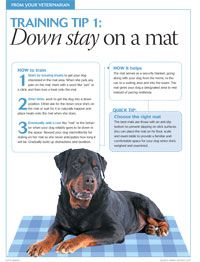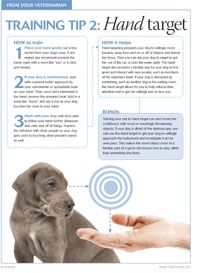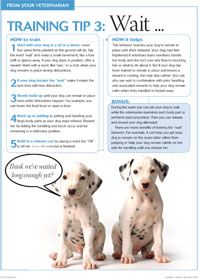Tricks for treats: How to train pets for a Fear-Free veterinary experience
Fear-Free veterinary visits start before the dog trots through your front door. Pet owners can help by training these three behaviors to make the exam a less stressful experience.

Bella and Buckley should have good doggy manners, and doggy parents just love showing off their precocious pooch's amazing abilities to sit, wait, jump through hoops and and rollover on command. But do your clients know that training also boosts their pooch's positive emotional state? Even better, a relaxed pup might just be more willing to do what you need her to do in the exam room. Sound too good to be true? It just takes a little training.
Veterinary visits are naturally frightening for many dogs because of the invasive nature of the work. When dogs feel uncomfortable or scared, they may freeze-and many progress to struggling, fleeing or fighting to get away. When the pooch panics this increases the risk of injury to the dog-and to your veterinary team-and may lead to pronounced fear during future veterinary visits.
Even the more laid back canines may have unique challenges if you're handling them in a sensitive area or they dislike a certain procedure, like nail trims. Or they may need guidance in tasks like remaining calmly in place on the scale and during an exam.
Training allows the pet owner to share a form of communication and cooperation with their dog. When dogs can willingly participate in their care, they are more relaxed and easy to handle during their visit. It also helps you refocus the dog when you need to either distract during handling or procedures and to help pups calm down when they're feeling upset.
Training is highly individualized, but every dog can benefit from learning three foundational behaviors for less stressful veterinary visits. Read on for three training tips and client handouts to educate pet owners.

Training tip 1: Down stay on a mat
Download the client handout (right) here.
How to train
1. Start by tossing treats to get your dog interested in the mat area. When she puts any paw on the mat, mark with a word like “yes” or a click, and then toss a treat onto the mat.
2. Over time, work to get the dog into a down position. Either ask for the down once she's on the mat or wait for it to naturally happen and place treats onto the mat when she does.
3. Eventually add a cue like “mat” to the behavior when your dog reliably goes to lie down in the space. Reward your dog intermittently for resting on her mat so she never anticipates how long it will be. Gradually build up distractions and duration.
How it helps
The mat serves as a security blanket, going along with your dog from the home, to the car, to a waiting area and into the exam. The mat gives your dog a designated area to rest instead of pacing restlessly.
Quick tip: Choose the right mat
The best mats are those with an anti-slip bottom to prevent slipping on slick surfaces. You can place the mat on he floor, scale and exam table to provide a familiar and comfortable space for your dog when she's weighed and examined.

Training tip 2: Hand target
Download the client handout (right) here.
How to train
1. Place your hand gently out a few inches from your dog's nose. If she makes any movement towards the hand, mark with a word like “yes” or a click, and reward.
2. If your dog is uninterested, start with a peanut butter approved by your veterinarian or spreadable treat on your hand. Then, once she's interested in the hand, remove the smeared treat. Add in a word like “touch” and say it just as your dog touches her nose to your hand.
3. Work with your dog until she's able to follow your hand further distances and onto and off of things. Practice the behavior with other people so your dog gets used to touching other people's hands as well.
How it helps
Hand targeting prepares your dog to willingly move towards, away from and on or off of objects and directs her focus. Then you can ask your dog to target to get her out of the car or onto the exam table. The hand target also provides a familiar way for your dog to first greet and interact with new people, such as members of the veterinary team. If your dog is distracted by something, such as another dog in the waiting room, the hand target allows for you to help refocus their attention and to get her willingly turn to face you.
Bonus: Training your pet to hand target can also boost her confidence with novel or seemingly threatening objects. If your dog is afraid of the stethoscope, you can use the hand target to get your dog to willingly approach the instrument and investigate it at her own pace. This makes the novel object more of a familiar part of a game she knows how to play rather than something she fears.

Training tip 3: Wait
Download the client handout (right) here.
How to train
1. Start with your dog in a sit or a down-even four paws firmly planted on the ground will do. Say the word “wait” and make a small movement, like a foot shift or glance away. If your dog stays in position, offer a reward. Mark with a word, like “yes,” or a click when your dog remains in place during distractions.
2. If your dog breaks the “wait” make it easier the next time with less distraction.
3. Slowly build up until your dog can remain in place even while distractions happen. For example, you can lower the food bowl or open a door.
4. Work up to adding in petting and handling your dog's body parts as your dog stays relaxed. Reward her for letting the handling and touch occur and for remaining in a stationary position.
5. Build in a release cue by saying a word like “OK” to let her know the exercise is finished.
How it helps
This behavior teaches your dog to remain in place until she's released. Your dog may feel frightened if veterinary team members handle her body and she isn't sure why they're touching her or what to do about it. But if your dog has been trained to remain in place and knows a reward is coming, she may stay calmer. You can also use wait in combination with prior handling and associated rewards to help your dog remain calm when she's handled in myriad ways.
Bonus: During the exam you can ask your dog to wait while the veterinarian examines each body part or performs each procedure. Then you can release and reward your dog afterward.
There are many benefits of training the “wait” behavior. For example, it can help you get your dog to remain on the exam table rather than jumping or help your dog remain calmly on her side for handling until you release her.